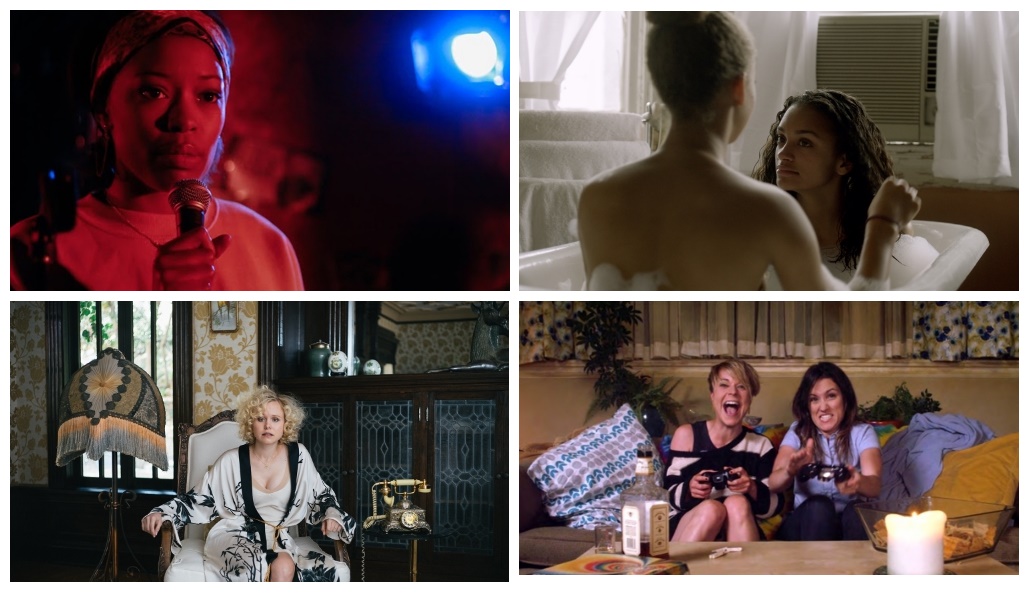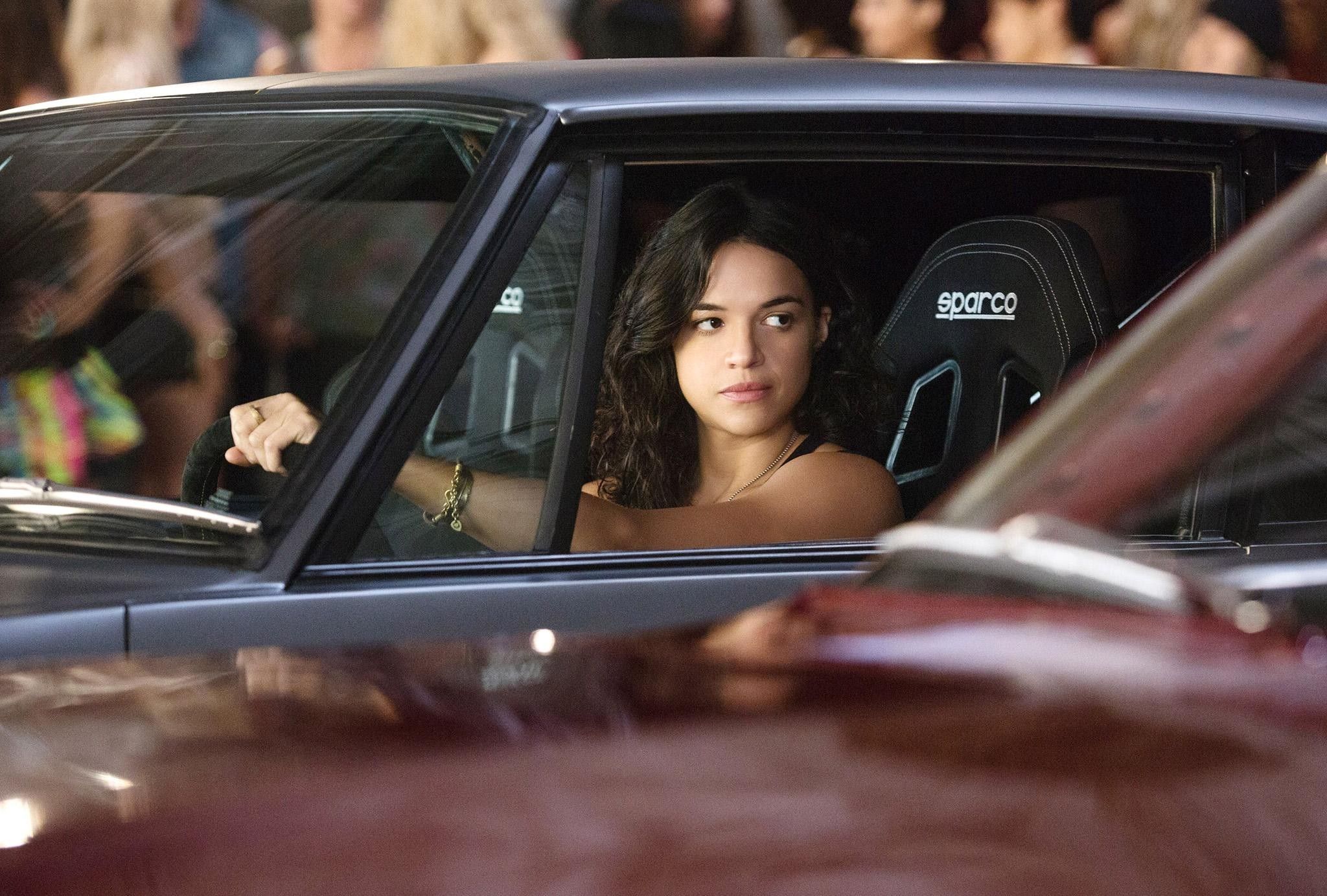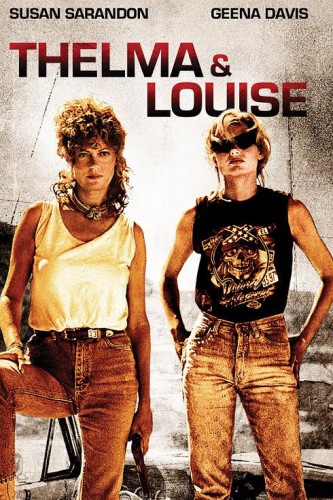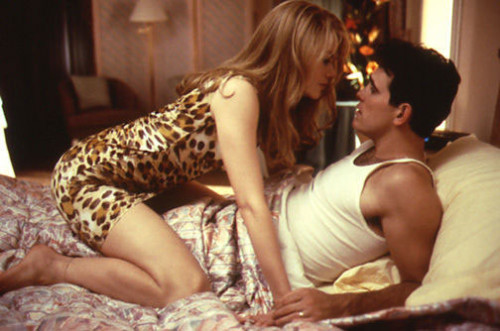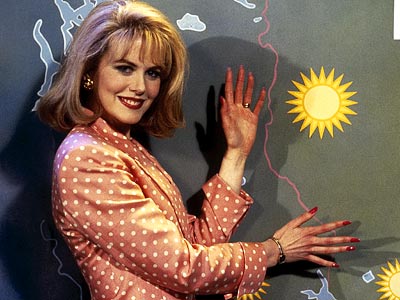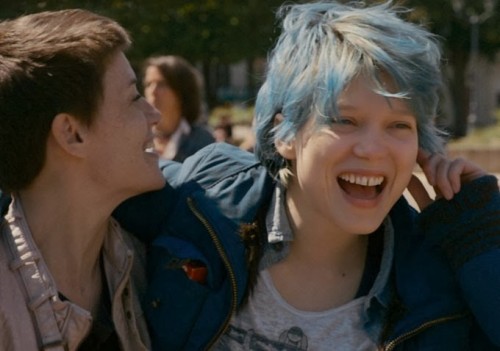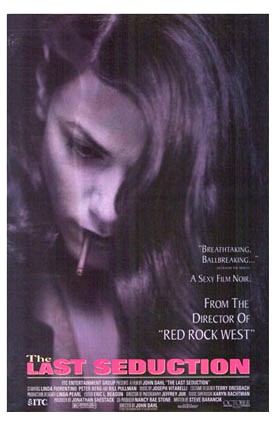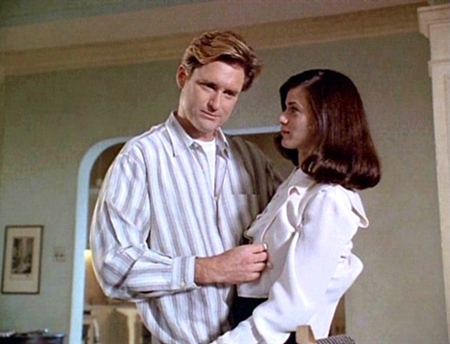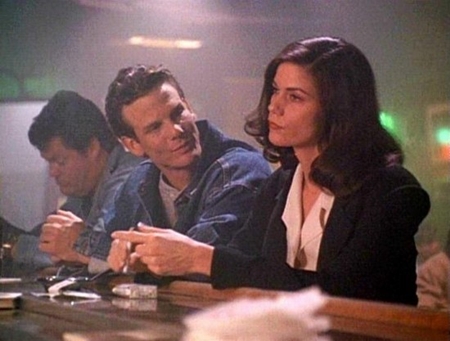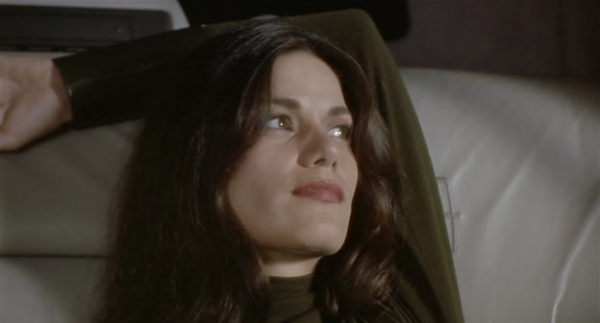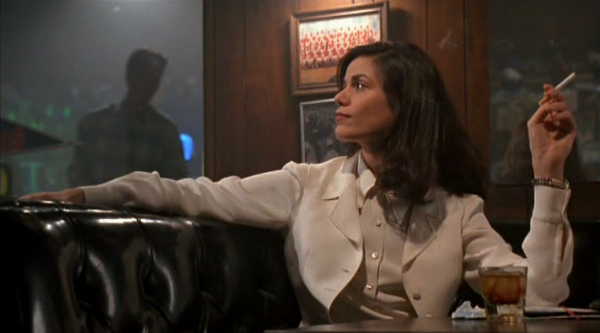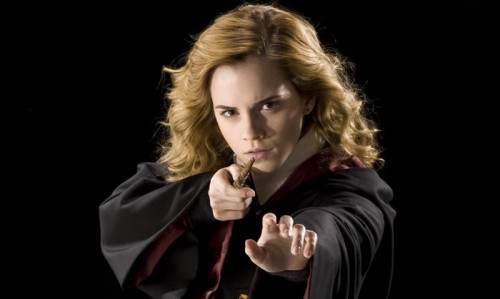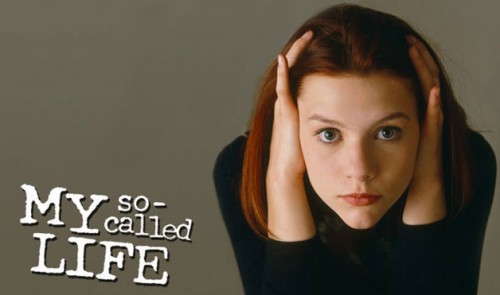This guest post by ThoughtPusher appears as part of our theme week on Dystopias.
Uh, like, 30 years ago or something, I was totally into a valley girl end-of-the-world scenario. Even! That’s like exactly what’s going on in Night of the Comet (so 1984) when this total bummer of an apocalypse happens on account of a comet that comes back after a wicked long time, the same one that like ended the dinosaurs and stuff, and so it totally wrecks the world just when these two teenage sisters were like about to grow up and get out from the bogus control their two-timing stepmom.
I remember loving Thom Eberhardt’s 1984 cult classic when I was younger, so I wanted to revisit it in all its glorious 80s post-apocalyptic deserted-downtown-L.A. splendor for this month’s theme week. But then I got a little nervous. (Stephanie Rogers just wrecked my assumption of great 80s movies with her dead-on reevaluation of the now-horrifying themes and language in Sixteen Candles, released in the same year as this flick.) Holy crap, what if my nostalgic adoration was misplaced and this killer zombie flick was really a social or moral nightmare to behold? Well, I watched it again, jaw and most muscles clenched, ready to suffer the pain of shattered dreams… but it really turned out to be OK-ish. Some cringe-worthiness, but not in the way I expected…
So this apocalypse deal could have been righteous. Like, fer sure. Especially for girls like Reg and Sam who got some kind of totally tubular elite kick-ass training from their military dad who wanted sons and treated them like they could grow up into Green Berets or something but then motored to fight some war when they got old enough to want to do girl things.
Regina (Catherine Mary Stewart) and her younger sister Samantha (Kelli Maroney) are a couple of valley girls who survive the initial wave of cosmic radiation emitted from the rare comet’s tail. They are left nearly alone to cope with a zombie apocalypse in downtown L.A. Their mom split after their dad came back from Vietnam, so they are used to taking care of themselves. Their dad did give them some training, though. As indicated by their male nicknames, it looks like their father would have been more interested in having sons. He trained them in weapons and hand-to-hand, but Reg reports that it became painfully obvious around sixth or seventh grade that they wouldn’t be go to Ranger school, so he went off to serve in more wars and conflicts. Even though he’s gone, he has prepared them to survive this kind of world.
Eberhardt’s vision for this dystopian landscape is empty, isolated, and eerily red, but still fully stocked with useful stuff like clothes and cars and radio stations. Yet these girls have been abandoned by both of their parents. Perhaps because of that, they stick together throughout the movie, and even get involved with a guy who has to check in on his mother (so he also doesn’t abandon his family or his new friends) and two kids who they essentially take in as niece and nephew to their little survivor clan.
As one house in a neighborhood party, Sam is pissed that her step-mom, Doris, has ordered her to serve chips and dip. This is just one of about a gazillion parties going on, not to mention a New Year’s Eve vibe on TV with handwritten posters and couples kissing in overcrowded public venues. Sam scoffs at Doris’s overly friendly relationship with a feelsy neighbor guy and sasses her way to calling Doris an asshole, which brings an immediate slap to Sam’s face. Sam slaps her in response, but then Doris wigs out and socks Sam so hard she tumbles over the couch. Like, some ditz can just deck a step-kid she’s supposed to take care of?! Doris sucks, so Sam could be all like, “What’s your damage?” and “Take a chill pill!” but she just jets without a place to go, so she spends the night in the lawn storage shed. That totally barfs me out, but I guess we’ve all gotten “shack” in MASH sometimes.
So the whole world parties in anticipation of this super-rare comet’s passage close to the atmosphere, except a few wary scientists who lock themselves in an underground bunker. Reg calls home and colludes with Sam (who is upholding a sisterly duty but completely unconvincing while doing it) to try to sell a “science trip” to the observatory as a reason to stay out all night. Doris lays out the situation: while the Major is away, she’s in charge. She doesn’t care what the girls do, but doesn’t want to be held responsible in case their dad survives and actually returns home. But as this scene plays out, the public corporal punishment of a teenage girl with a bad attitude seems acceptable.

This might be the most disturbing scene in the movie, even though it is before the apocalyptic crisis or the zombie attacks or the ensuing power-struggles. It just seems so normal, so acceptable, so parental for Doris to punch Sam across the room. There are even neighbors in the doorway who glance over during the domestic altercation but do nothing other than continue their conversation. The dystopian landscape of this horror movie turns out to be the contemporary social conventions and what is deemed permissible in the treatment of children. Of course there are parties everywhere. Of course a few scientists and military men take precautions and later bring unexposed survivors (including kids) back to their bunker to use them for their physical production of healthy blood. But aside from the anticipated decadence and violence and darker side of humanity, this pre-comet event is what takes my breath away for a moment as the corners of my eyes cringe at the abrupt violence. Sam’s encounter with Doris and her behavior during her conversation with Reg the next morning run the gamut of trauma reactions: she is shocked, then saddened, then runs away, then tries to conceal the bruising with makeup, then jokes about it, then angry enough to tell her dad and try to get Doris out of their lives. (But she doesn’t get quite to that stage of the process until Reg comes home the next morning…)
After playing an arcade game for a while and thinking that her projectionist pseudo-boyfriend has ditched her, Reg goes outside and gets locked out of the dive theater. She spazzes out when she runs into this fugly zombie creepazoid in the alley who looks like he could be a Garbage Pail Kid. He’s scabby and oozy and should totally bag his face. Gag me with a spoon! But Reg fights him off and hops on Larry’s motorcycle to book it home. Nobody is around but the stuff from the party is still in the street along with clothes and grosser-than-gross red dust, so she looks for Sam to find out what’s up.
Reg has some hand-to-hand skills (not to mention her later comment that “the mac-10 submachine gun was practically designed for housewives”), so she survives the attack. But the thing that always stood out to me about this was the nonchalance of her ability to hop onto a motorcycle and drive off. Although Eberhardt presents an strangely empty L.A., most post-apocalyptic cities are represented as worlds where abandoned vehicles clutter the roads; if you want to travel from place to place with ease, you should ride a bike… it’s a part of a lot of movies in the genre, but that just seems like a survival skill that most teenage girls lack in traditional portrayals. I mean, she doesn’t wrap her arms around some guy’s waist to hold on for the ride of her life or even jump onto a Vespa or something weak. Nope, she’s a zombie-fightin’ shoulder-padded biker who escapes danger on her own and looks just as feathery-haired good when she gets to her destination as when she put down her attacker in the alley (although this was the early 80s while CFCs were being phased out, so big hair treated with a half-bottle of AquaNet always had some hold). Reg initiates the era of a fashionable, kick-ass heroine with a sharp wit and massive protective instincts. (Can anyone say Buffy, or Zoë, or Buffyverse, or River, or Echo, or any other female leads in forthcoming Joss Whedon projects?) Even later in the movie, Reg sees Sam after being told that she was dead; and their conversation shifts quickly from relieved surprise to “Hey, that’s a great outfit!” / “Thanks. Is that guy in the hallway dead?” It seems to foreshadow the content and mood of the closing sequences of most Buffy episodes.
Reg tries to tell Sam that there is something messed up with the world, but Sam applies some makeup in the mirror to cover up the bruise from the night before. (Dude! It’s all kinds of “I walked into a door again” and stuff.) Instead of dealing with what Reg is saying, Sam carries her boom box from room to room, which is what gives them the idea to go to the local radio station ‘cause the dj’s counting down the weekly top twenty, so he might have the 411 on what happened the night before since he does the news and stuff. When they get to the station, it’s like all automated but a guy with a gun comes at the girls to see if they’re still human. Hector is this trucker just passing through town, but he had the same idea about maybe somebody being at the station. Sam finds the controls and gets to be the new dj, which is totally rad.
(OK, so I get that it’s a plot point to go to the broadcasting source, but having a radio station setting in the course of the movie was so 80s. [sigh…] God I miss 80s movie soundtracks.)
When Hector gets the drop on the girls at the radio station, Reg tries to negotiate Sam’s release. She is the big sister and is going to take care of Sam. But it gets fun when Sam starts broadcasting, choosing what songs to play and talking over them to any audience that might be listening. She proclaims herself to be one-third owner of the station, and then begins changing the world order: all finals are cancelled, and the new drinking age is 10… with ID. She gets a call on the “hit line” and loses the connection, but the broadcast continues and the scientists in the desert compound deduce that the normalcy of the radio station will keep the small group there long enough to retrieve them. After all, the not-so-smart scientists left the vents open in their bunker, so they were partially exposed to the comet’s radiation and they are slowly turning into zombies. (The scientists in this little sci-fi story are not the knowledgeable crowd usually portrayed.)
During a bad dream, Sam is driving and defending herself from the fault of losing the connection with the scientists when she exclaims, “I’m not the phone company… nobody’s the phone company anymore!” She recognizes that no one is responsible for the phone lines, but she also starts to freak out when a cop pulls her over. She doesn’t have her license, so she’s sure she will be in trouble. This is all part of a dream (within a dream to boot), but it demonstrates the inherent assumption of civil authority over personal behavior. And it’s far from Eberhardt’s only reference to traffic violations and rules of the road.
Hector announces that he has to go to San Diego in the morning, and Reg wonders why. Even though Hector has a mother and sister and friends there, she assumes they’re gone. After a bit of getting-to-know-you personal time, Hector jokes, “What will you give me if I come back?” Reg ponders this and offers up Texas. Then Florida and Texas. Hector counters with Florida, Texas, and Hawaii. Territories don’t seem to matter much anymore. But the next morning Hector leaves and later Sam has it out with Reg about the older sister getting every guy Sam ever had her eye on, and now probably has the last guy in the world. After a slight pause, they both start laughing this off. Sibling rivalry takes a back seat to survival, and they have a real heartfelt moment together in their next encounter.

This is a soft conversation between sisters in the midst of a desolate landscape, but Eberhardt chooses a really nice visual presentation: the girls sit on the hood of a police car, Reg in the cop’s jacket twirling a nightstick and Sam still in her cheerleading uniform. Sam talks about a boy she liked who was going to ask her out and a friend who was trying to figure out how to keep her parents from finding out she was flunking algebra. All those problems are completely detached from their present condition. Sam is down and wants to go home to change, but Reg does a big sister job of cheering her up: the stores are open and there’s no need for credit cards! (Cut to an awesome mall-shopping montage set to the recognizable beat but different singer of “Girls Just Want to Have Fun.”) As one of the scientists will later note, they are in the midst of a monument of consumerism. Unlike the lack of resources that lead to the corruption of humanity in many dystopian presentations, this kind of immediate isolation in a wasteland of material bounty provides a wealth of available goods free for all those who want them.
Later at the galleria, these grody-to-the-max half-zombie wastoids are so out there. I mean, they’re like so gross and want to take control of the girls for invading their space where they were stock-boys but now think they’re all kinds of important and stuff. What neo-maxi-zoom-dweebies! But the wannabe henchmen are like total space-cadet hosers and can’t do anything without the gnarly leader guy telling them what to do. Like, I’m sure.
Sam asks for Reg’s fashion advice and then why she chooses one piece of clothing over another. Reg states quite obviously, “Because it’ll stay in style longer.” There’s just stuff going on in this whole movie about social standards that remain intact even after the people in society disappear. And I think that’s pretty cool.
The girls get captured by the stock-boy zombies, but the scientists from the compound have come to town looking for the radio-station survivors. They rescue the girls from the stock boys in time to take Reg back. They wait for Hector to return and they secretly plan to kill Sam because she is exhibiting signs of zombie-onset. (They don’t know that she breaks out in a rash like whenever she’s stressed.) However, one scientist among the group doesn’t think their survival trumps the welfare of healthy survivors. She had a problem with bringing any survivors into the facility for testing, even before two kids arrive in pajamas like they were just pulled from their Saturday morning cartoons.
She saves Sam by dosing her with a sedative that makes her look like she is dead, leaves the rag-tag group some field notes to brief them on the global situation and what is going on in the research facility, and takes her own life before she turns into a zombie. Hector does come back, and Sam joins him to go to the research facility to rescue Reg, along with the two kids that were brought in earlier, Sarah and Brian. The sisters and Hector (who seems to have enough knowledge of explosives to MacGyver some car bombs to avoid chase at the climax) seem like they will get along just fine once this whole zombie problem runs its course.
Night of the Comet doesn’t present typical military fears of the genre (since their dad trained the girls before going back to service), but silhouettes and partial frames of guards in and around the underground compound suggest an armed force aligned with the scientists. The scary factor here might just be the idea that (compared to the rest of the world we’ve seen survive) the group in the bunker seem to have knowledge of the situation and the power to take the measures they deem fit as best for their group, regardless of how many healthy survivors they have to use as their own personal unconscious blood banks. But if they are the smart ones, who the heck left the vents open?
I kid you not: I woulda veged with nobody to tell me what to do, but Reg steps up and takes charge of family life like it’s no biggie at all. She’s like all conventional-o-rama, and seeing it start to play out makes Sam think she’s left with a lame-ass Joanie future. But then Sam is stoked to find a stud of her own who rolls up in a choice ‘Cedes out his fresh-to-death collection of 23 cars. He is totally on board with the rules of the road, so when Sam brings up what could be a downer of a reality, he thinks it’s a bitchin’ prospect to be, like, responsible for the future of civilization. Yar!
The newly formed family unit is all dressed up in their Sunday best, and Reg is taking Polaroids of the kids as they stand for the pictures smiling but rolling their eyes in between shots. Reg moves to fix their clothes and hair, telling them that she needs to take a few more pictures, so “don’t slouch.” To the side, Hector drops their cache of guns in to a trashcan. Sarah asks if she can have a gun since they are going to waste. Reg, shaking the development of another picture, says to Hector, “Don’t look at me. I mean, I don’t know where she gets that stuff.” Reg has taken on the responsibility to raise a proper family, which apparently involves placing blame on external sources for any questionable behavior.
The happy family walks down from a plaza toward a street, and across from them Sam starts ruminating on her possible future, mumbling, “Maybe I could be a nun or something.” The family walks to the crosswalk, and Reg pushes the button for the walk sign. Sam thinks that they look like the Brady Bunch and yells out to ask why they are waiting. Hector says that they are waiting for the light to change. In disbelief, Sam questions their sanity, but Reg replies, “The whole burden of civilization has fallen upon us.” Reg then adds the edict: “It means we do not cross against the light!” Reg recognizes that even in an isolated existence some social standards must be maintained. Sam runs into the middle of the street as she proclaims how stupid it is to wait for the light when there is no one else in their ghost town.

Suddenly, a car turns the corner and speeds down the street, swerving as Sam bolts away. Reg reinforces the lesson as she looks down at Brian to ask rhetorically, “See what happens?” Lesson learned, the boy nods as the car screeches around to return to Sam. The driver circles back to apologize, but also notes, “God, I’m sorry, but you shouldn’t cross against the light like that.” As they both pull up their sunglasses (since they are both wearing cool shades by the standards of any pre- or post-apocalyptic social trends), the guy smartly deduces that they are survivors, too. Sam agrees to go for a ride without any hesitation. Hector asks who this guy is, why they should trust him, and so Sam gets his name. Reg tells them to be back by midnight, and he is shocked at the imposition of a curfew. Sam repeats the reasoning: “The burden of civilization is on us, OK?” They agree that that is a bitchin’ prospect, and they drive off, the family waving them goodbye from the middle of the street.
The whole traffic-law scenario hearkens back to Reg’s initial escape from the theater alley: she drives the motorcycle on the empty streets but comes to a complete stop at a red light and takes a moment to turn on the headlight. Traffic safety might not seem like the first bastion of social order, but the rules of the road set up the foundation of civilized behavior. Even if no one’s around, you don’t run a red light. I really hope Eberhardt intended for that theme to show through in so many scenes.
What would you do to reinforce the social acceptability of some behavior? Would you sweep the leg in obedience? Would you buzz the tower in defiance? Would you beat down your step-kid when she won’t serve hors d’oeuvres at your decadent party? Would you check in on your parents even if all rational hope for their survival is lost? Would you rescue kids being exploited by others and try to teach them life lessons? Would you look both ways and refuse to cross against the light? Yeah, I can see how that one might stand out as somewhat insignificant, but once you start deciding what kind of world order you would choose, the burden of civilization is on you… and that is a totally bitchin’ landscape, dude.
ThoughtPusher might live somewhere near you (especially if you have a neighbor who blasts New Order or Tears for Fears most nights), but certainly is a cinephile who has no interest in being followed or asking to be liked.
